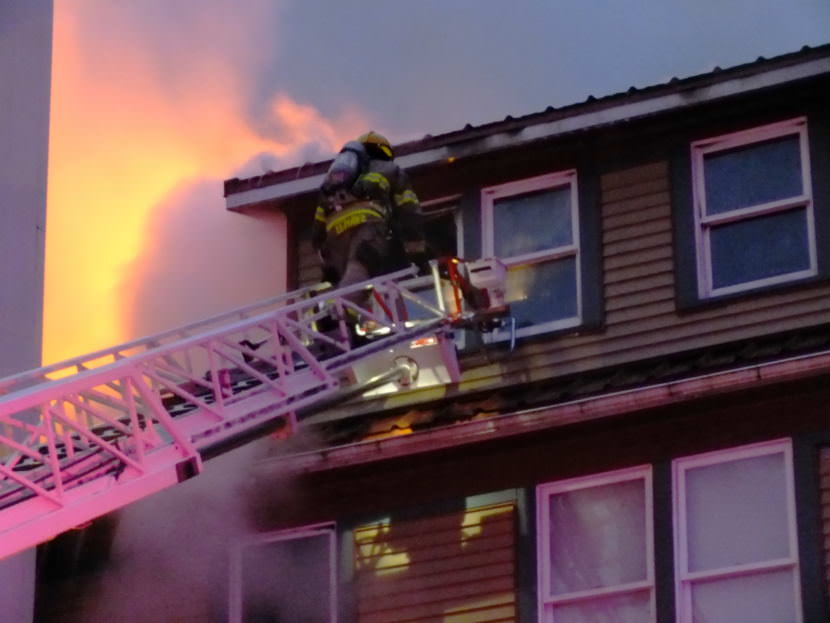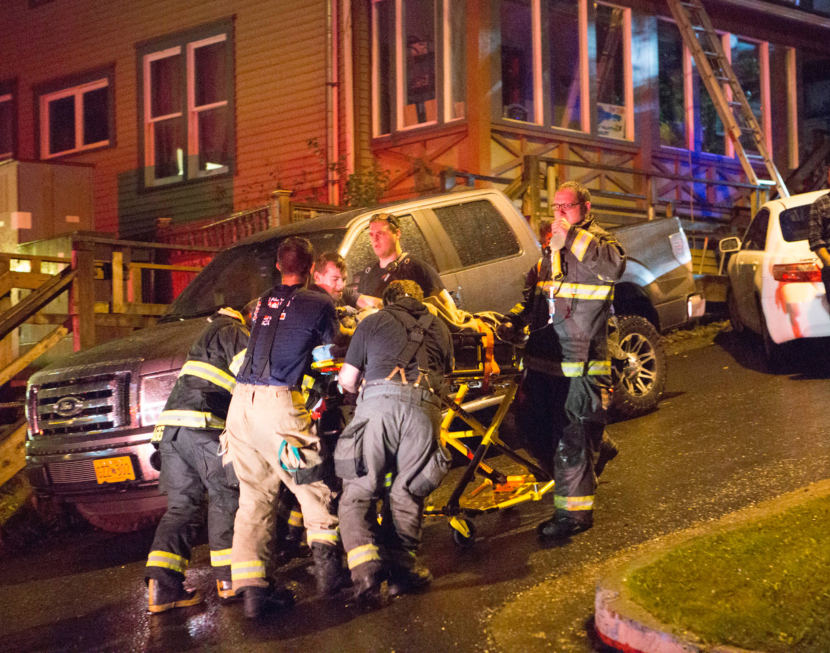
The Juneau Assembly will consider Monday adding funding for a third, year-round ambulance for Capital City Fire/Rescue.
Both the city administration and front-line firefighters say the fire department already is stretched thin, and the extra staff is necessary to respond to a dramatic increase in medical calls.
“Make sure you have your air on before you go in,” said a firefighter trainer at the Hagevig Fire Training Center, his voice muffled by his facemask.
The trainer is instructing a firefighter trainee about how to perform a search and rescue in a burning structure.
“Get down low!”
Both men are dressed in bunker gear with an air tank and breathing apparatus. They get on their knees in a pitch-dark, smoky and hot room, to find a fire victim and drag him out to safety.
The exercise was a crash course in firefighting training for Assembly members and Juneau media a few years ago.
The trainee quickly becomes disoriented and exhausted. And, if he doesn’t help rescue the victim before he runs out of air, he may suffer from smoke inhalation, even suffocate.
That training scenario is almost identical to last September’s fatal Seward Street house fire.
Two people in the house were killed. Four firefighters suffered from exhaustion and smoke inhalation, injuries partially sustained while trying to rescue victims when their air ran out.
“What happened on that fire is that our crews were tired and worn out responding to lots of call volume and they had trouble mustering enough people to respond to what should have been a relatively simple house fire,” City Manager Rorie Watt said. “That is worrisome.”
Fire Chief Rich Etheridge said only the downtown engine — with two firefighters aboard — could initially respond.
Emergency medical technicians usually cross-train as firefighters, but on that night, the downtown ambulance with two EMTs was already busy with a medical call.
Another ambulance had to be dispatched from the Mendenhall Valley, and police officers and bystanders were drafted to move air bottles and help with other duties.
Etheridge said volunteers and off-duty career firefighters eventually responded to the scene.
“That one was kind of the straw that broke the camel’s back that spurred the firefighters to go before the Assembly and say ‘Hey, here’s the reality of what we face on a regular basis,’” Etheridge said.
The City and Borough of Juneau hired the firm Fitch and Associates to take an objective look at CCFR.
Etheridge said it was good for an outside, third-party to document what Juneau firefighters already knew.
“We do have a lot of calls. We do need more staffing to cover them,” Etheridge said. “Approximately 20 percent of the time, our apparatus are already on calls when additional calls for service come in.”
Those overlapping calls create delays.
“If you’re having chest pains, difficulty breathing, if you’re bleeding, if one of your loved ones is experiencing an emergency like that, when you call 911, you’ve got the expectation that you’re going to have help showing up very quickly,” Etheridge said. “If you call 911 and they tell you it’s going to be 20, 30 minutes for someone to arrive to help you out, that’s not at all what people come to expect out of a 911 system.”

According to the Fitch study, the volume or the overall number of 911 calls increased dramatically, as much as 40 percent over the past eight years.
Older structures and Juneau’s aging population are some of the big reason for the increase.
Capital City Fire/Rescue receives an average of 14 calls each day — most for emergency medical care.
As an immediate measure, City Manager Rorie Watt proposes adding another ambulance crew for $361,000, adding to the fire department’s nearly $9 million budget.
“I think it’s good the public is focused on this,” Watt said. “It’s a good question. It’s a core piece of municipal service.”
Firefighters have been lobbying the Assembly to approve funding for six EMT/firefighters working 24-hour shifts to cover overnight calls.
The local firefighters union argues it would be cost-effective.
“We have to prioritize and we have to leave people waiting,” said Travis Wolfe, president of the International Association of Firefighters (IAFF) Local 4303. “We can do better in Juneau. We need that third ambulance. It’ll make the difference.”
Still, six EMT/firefighters are not quite enough for Wolfe. He wants to add at least nine.
“Those firefighters can be the difference on these emergency scenes for search and rescue, ventilation, fire attack,” Wolfe said. “The more people we can get there on that first alarm, the faster we can put the fire out, the faster we can make a difference in someone else’s life.”
Wolfe also wants to build up the volunteer program, which is normally the training ground for entry-level career firefighters.
Finance Committee Chairman Jesse Kiehl said whatever the Assembly decides, it probably won’t be the last word.
“I don’t believe we’ll add a single ambulance crew and be all better,” Kiehl said. “This community needs somebody to come when we call 911.”
Aside from the immediate staffing increase, Watt said other issues raised in the Fitch and Associates study — such as fire department reorganization, volunteer training, and even the dispatching of fire engines to medical calls – also need to be examined.
Correction: An earlier version of this story misstated some of the particular staffing levels and funding levels the Assembly would consider. Those references have been deleted.
